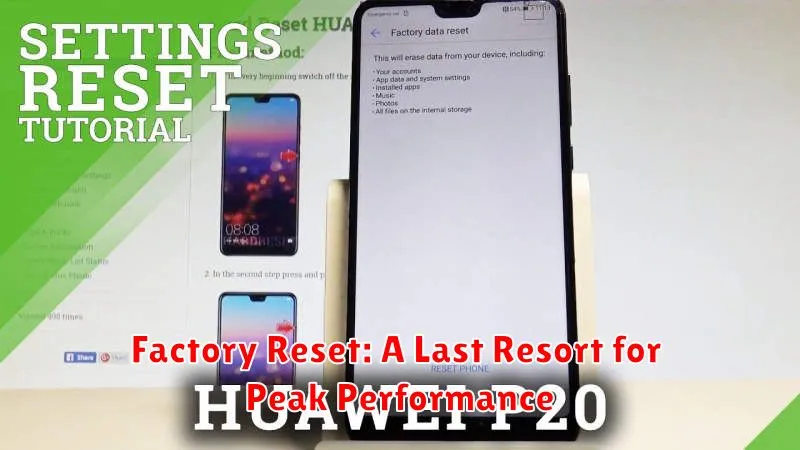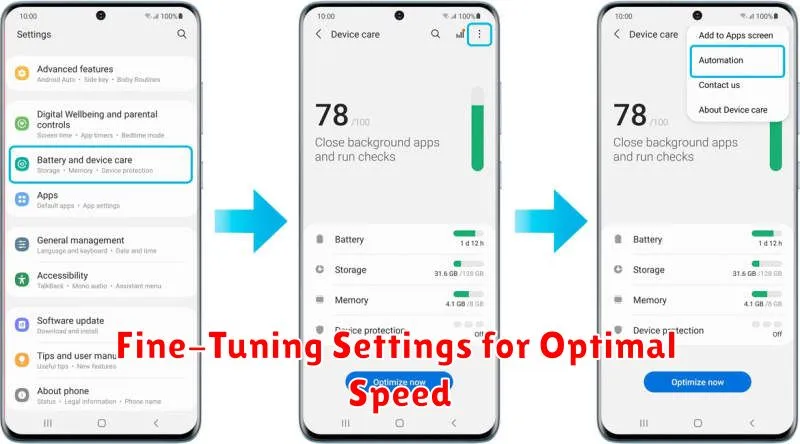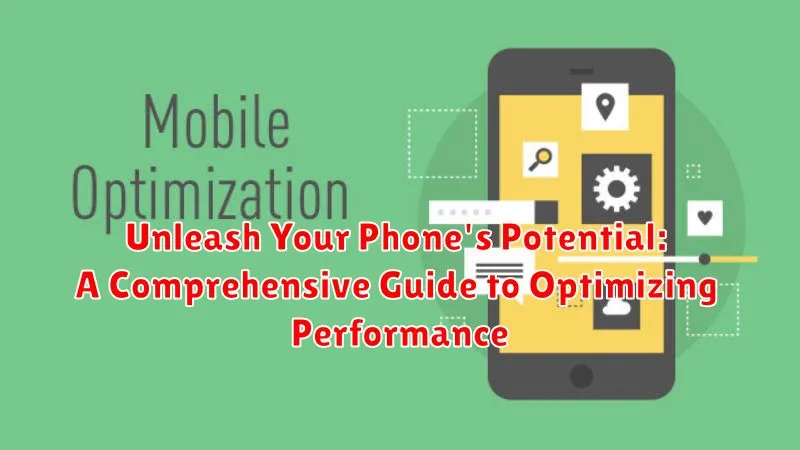Is your phone feeling sluggish? Does it take forever to load apps or struggle to keep up with your daily demands? You’re not alone. Many users experience performance degradation over time, but it doesn’t have to be that way. This comprehensive guide will empower you to unleash your phone’s potential and achieve optimal performance. We’ll explore proven techniques and strategies to optimize every aspect of your device, from speed and battery life to storage and security. Whether you’re an Android user or an iPhone enthusiast, preparing for a new software update, or simply looking to revitalize your current device, this guide will provide you with the knowledge and tools you need to take control and experience the true capabilities of your phone.
Within these pages, you will discover how to maximize performance, extend battery life, free up valuable storage space, and enhance your phone’s security. We will delve into the intricacies of operating system optimization, app management, and hardware maintenance, providing practical tips and actionable steps you can implement immediately. Whether you’re looking for quick wins or a deep dive into advanced settings, this guide is designed to cater to all levels of technical expertise, helping you unlock the full potential of your smartphone and enjoy a seamless and efficient mobile experience.
Identifying Performance Bottlenecks
Before diving into solutions, it’s crucial to pinpoint the specific issues hindering your phone’s performance. A slowdown can stem from various sources, making proper diagnosis essential for effective optimization.
One common culprit is resource-intensive apps. Monitor your phone’s activity to identify apps consuming excessive processing power or memory. The built-in monitoring tools or task managers often provide this information.
Another bottleneck can arise from operating system updates. While updates generally improve performance, occasionally, they can introduce compatibility issues or bugs that negatively impact speed. Check online forums or support pages for reports of performance problems after recent updates.
Hardware limitations also play a role. Older devices or those with less RAM and processing power may struggle to keep up with demanding tasks or newer apps. Consider your phone’s specifications when assessing potential bottlenecks.
Clearing App Cache and Data for a Fresh Start
Over time, apps accumulate cached data and files that can eventually hinder performance. Clearing these can often resolve sluggishness and free up valuable storage space. Cache refers to temporary files stored by apps to speed up loading times. While generally beneficial, corrupted or outdated cache can cause issues. Data, on the other hand, includes user-specific information like login details and preferences.
Clearing the cache is a relatively safe process that typically doesn’t remove crucial data. However, clearing app data will reset the app to its default state, as if freshly installed. This means you might need to re-enter login credentials and reconfigure settings. Therefore, it’s recommended to clear the cache first and only proceed to clearing data if performance issues persist.
Most Android devices offer a way to clear cache and data through the Settings app. Navigate to the Apps section, select the desired app, and then access its storage options. From there, you can choose to clear cache or data individually. Be mindful of the implications of clearing data before proceeding.
Optimizing Background Processes and Battery Drain
Background processes, while often essential for app functionality, can significantly impact both performance and battery life. Unnecessary background activity consumes processing power and drains your battery, leading to a sluggish user experience and reduced uptime.
Limiting background processes is crucial for optimizing your phone’s resources. Most modern operating systems provide built-in tools to manage which apps are allowed to run in the background. Review these settings and restrict background activity for apps you don’t frequently use.
Battery optimization features offered by the OS can further help extend battery life. These features often employ intelligent algorithms to identify and restrict power-hungry background processes. Enabling these features can significantly improve battery performance without requiring manual intervention.
Regularly reviewing app permissions can also prevent unnecessary background activity. Be mindful of which apps have access to location services, microphone, or camera. Revoking unnecessary permissions can not only improve privacy but also reduce background drain.
The Impact of Storage Management on Speed
Your phone’s storage plays a critical role in its overall performance. A cluttered storage space can significantly slow down operations, affecting everything from app launch times to general navigation. When your phone’s storage is nearly full, the system struggles to find space for temporary files and processes, leading to noticeable sluggishness.
Think of it like a packed closet. The more crammed it is, the harder it is to find what you need quickly. Similarly, a full storage drive forces the phone’s processor to work harder, searching through a dense collection of data. This extra effort translates directly into slower processing speeds and a less responsive device. Regularly managing your storage can prevent this bottleneck.
Key areas to focus on include deleting unused apps, clearing cached data, and transferring photos and videos to cloud storage or an external drive. By proactively managing your storage, you create breathing room for your device to operate efficiently, ensuring optimal performance and a smoother user experience.
Leveraging Performance-Boosting Apps
While a cautious approach is recommended when considering third-party apps claiming performance enhancements, some legitimate options can aid in specific areas. System monitoring apps can provide valuable insights into resource consumption, helping identify power-hungry processes or apps. These apps often present detailed breakdowns of CPU usage, RAM allocation, and battery drain per app.
Cache cleaners can offer a more convenient way to clear app caches, but exercise caution as overuse can hinder app performance. Aggressive cache clearing forces apps to reload data frequently, negating the benefits of cached information. Some performance-boosting apps also offer game boosters, which prioritize system resources for gaming, potentially improving frame rates and responsiveness.
Regular Software Updates: The Key to Smooth Operation
Keeping your phone’s software updated is crucial for maintaining optimal performance. Software updates often include performance enhancements, bug fixes, and new features that can significantly improve your phone’s speed and responsiveness.
These updates address underlying issues that can cause lag, battery drain, and app crashes. They also introduce optimizations for existing hardware and software, leading to a smoother overall experience. Think of it as routine maintenance for your phone’s internal workings.
Manufacturers regularly release updates to patch security vulnerabilities. Installing these updates is vital to protect your phone from malware and other security threats. A secure phone is a more efficiently running phone, free from the burden of unwanted processes.
Ignoring updates can lead to a gradual decline in performance over time. So, it’s recommended to enable automatic updates whenever possible. This ensures your phone is always running the latest and most efficient software version, keeping it at peak performance.
Factory Reset: A Last Resort for Peak Performance

A factory reset returns your phone to its original state, erasing all data and settings. While a powerful tool for resolving persistent performance issues, it should be considered a last resort after exhausting other optimization methods. Before proceeding, back up all important data as this process is irreversible.
A factory reset can be beneficial when your phone experiences significant slowdowns, frequent crashes, or unresponsive behavior that other troubleshooting steps haven’t resolved. It eliminates accumulated data, corrupted files, and problematic apps that may be hindering performance.
The process for initiating a factory reset varies depending on your phone’s operating system and manufacturer. Generally, it involves navigating to the settings menu, finding the backup and reset option, and selecting factory data reset. Always consult your phone’s user manual or manufacturer’s website for device-specific instructions.
Fine-Tuning Settings for Optimal Speed

Beyond software updates and resets, fine-tuning specific settings can significantly enhance your phone’s speed and responsiveness. These adjustments often involve managing resources and limiting background activity.
Animation Scales
Reducing or disabling animation scales can create a noticeable improvement in perceived speed. While visually appealing, animations consume resources and introduce slight delays. Explore your phone’s developer options to modify these settings.
Background Processes
Limiting the number of apps running in the background frees up system resources like RAM and processing power. Close unused apps regularly and review your phone’s battery optimization settings to manage background activity.
Data Usage
While not directly impacting processing speed, managing data usage can improve perceived performance, especially on slower networks. Restricting background data for non-essential apps can minimize lag when browsing or using data-intensive applications.

